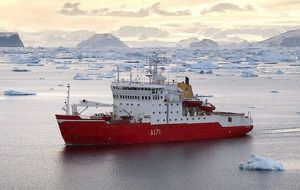MercoPress. South Atlantic News Agency
Ice patrol HMS Endurance dilemma disclosed

The details of HMS Endurance’s struggle for survival last December has up until now been kept from the public domain. In this month’s edition of Navy News, however, details of the challenges overcome by the ship and crew have finally been released.
However, the cause of the incident, which resulted in the engine room flooding and which very nearly forced the crew to abandon ship, is still the subject of an official Service Inquiry report and has not yet been revealed.
The water first flooded the engine room at four in the afternoon on December 16. As all the major machinery was in one compartment, the HMS Endurance very soon lost all power and propulsion, with signals and emails failing, leaving the only form of communication as satellite telephones.
For the next eight hours the ship’s company bailed water attempting to control the flood, the water coming through onto the deck head and accommodation deck – the engine room had to be evacuated very quickly due to the speed of the water infiltrating the vessel.
At this time the ship was drifting in a 40-50 knot north-westerly, rolling 30 degrees to either side, with the water moving around adding to the instability of the vessel, Navy News have reported. As HMS Endurance was located close to rocks in the Western Magellan Strait the situation was deemed serious.
Teams in the UK, at Fleet HQ in Northwood and Abbey Wood were brought together. After studying plans of the Endurance naval architects told Lt Cdr Sharpe that they would be nearing stability limits, and there was a high possibility they would be forced to evacuate.
The first ship to offer assistance to the vessel was a pilot cutter, the Pudu, which the Navy News said, was deemed too small to help, particularly considering sea conditions.
The Norwegian Sun, a 7,000-ton cruise liner with 3,000 passengers, was then contacted, which made her way towards the stricken vessel.
As Endurance was still drifting at about two knots, Lt Cdr Sharpe decided to let the starboard anchor out. 250 metres in length, the anchor didn’t slow the vessel at first, only altering the direction of drift which gave the crew a little more time.
At this point Endurance’s luck changed as they were passing above the only shallow part of the Western Magellan Strait, an 80 metre contour. At 11pm, the anchor finally held onto a rocky pinnacle as PO Rieder Freeland told Navy News: “The ship’s head started to come into wind and I knew the anchor was holding. If it hadn’t, the next option almost immediately would have been to get off.”
With the port anchor also securing the vessel, the aggressive rolling was replaced by a much more manageable pitching, and plans to tow the Endurance to a safe location was discussed. There were originally plans for the Norwegian Sun to assist, but with 3,000 passengers on board, at night and coming within 100 metres of the rocks, this course of action was decided against. In the end the crew and vessel waited until a Chilean salvage tug arrived, and after cutting the anchors (the hydraulics were also damaged), were towed to calm water within two hours.
Endurance was then brought to the Falkland Islands as previously reported, before being loaded onto a heavy lift vessel and returned to Portsmouth. Penguin News




Top Comments
Disclaimer & comment rules-

-

-

Read all commentsWill she ever be back patrolling in the falklands and adjacent territories??????
May 15th, 2009 - 04:30 am 0alguién puede ser tan ingenuo como para creer que haya sido un accidente lo del Endurance??
May 15th, 2009 - 10:04 am 0I see no mention of the part of the chile navy.
May 24th, 2009 - 03:36 am 0Commenting for this story is now closed.
If you have a Facebook account, become a fan and comment on our Facebook Page!